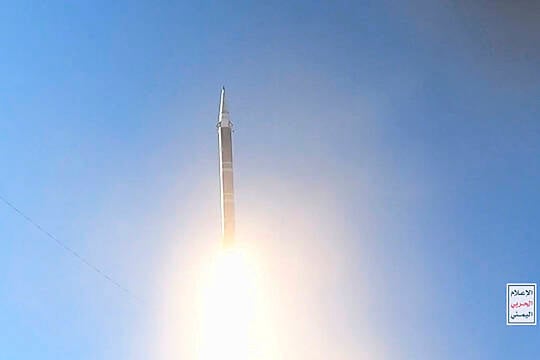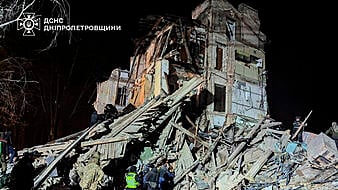Yemen’s Houthi rebels have unveiled a new solid-fuel missile that resembles aspects of one earlier displayed by Iran that Tehran said could fly at hypersonic speeds.
The rebels fired the new Palestine missile, complete with a warhead painted like a Palestinian checkered scarf, at the southern Gulf of Aqaba port of Eilat in Israel on Monday.
The attack set off air raid sirens but caused no reported damage or injuries.
Footage released by the Houthis late on Wednesday showed the Palestine being raised on what appeared to be a mobile launcher and rising quickly into the air with plumes of white smoke coming from its engine. White smoke is common with solid-fuel missiles.

Solid-fuel missiles can be set up and fired faster than those containing liquid fuel, which is a key concern for the Houthis as their missile launch sites have been repeatedly targeted by US and allied forces in recent months over the rebels’ attacks on shipping through the Red Sea corridor.
One such strike hit the Houthis even before they were able to launch their missile.
The Houthis described the Palestine as a “locally made” missile, although they are not known to possess the ability to manufacture complicated missile and guidance systems locally in Yemen, the Arab world’s poorest country, which has been gripped by war since the rebels seized the capital Sanaa nearly a decade ago.
The Houthis have been repeatedly armed by Iran during the war despite a United Nations arms embargo. While Iran claims it does not arm the Houthis, ships seized by the US and its allies have found Iranian weaponry, missile fuel and components on board.
Iranian media reported the launch of the Palestine and described it as locally manufactured, citing the Houthis. However, design elements resemble other missiles developed by Iran’s paramilitary Revolutionary Guard, including the Fattah, or “Conqueror” in Farsi.
Iran unveiled the missile last year and claimed it could reach Mach 15th — 15 times the speed of sound. It described the missile’s range as up to 870 miles, which is a little short of Eilat from Houthi-controlled areas of Yemen, but the missile can be reconfigured to boost its range.
The IRGC-developed Fattah 1 and the Kheybarshekan 2 look pretty similar to the Palestine. It seems quite likely that the Palestine is either of these two designs. We do not know the range of the Kheybarshekan 2. The Fattah range should be 1450km but there are always ways to… pic.twitter.com/cQvKKjRG0Y
Advertisement— Fabian Hinz (@fab_hinz) June 5, 2024
In March, Russia’s state-run RIA Novosti news agency quoted an anonymous source claiming the Houthis had a hypersonic missile.
“While we cannot say for sure what exact version the Palestine corresponds to, we can say with high certainty that is is an advanced and precision-guided (Guard)-developed solid propellant missile provided by Iran,” wrote Fabian Hinz, a missile expert and research fellow at the International Institute for Strategic Studies.
Hypersonic weapons, which fly at speeds higher than Mach 5, could pose crucial challenges to missile defence systems because of their speed and manoeuvrability.
Ballistic weapons fly on a trajectory in which anti-missile systems like the US-made Patriot can anticipate their path and intercept them. The more irregular the missile’s flight path, such as a hypersonic missile with the ability to change directions, the more difficult it becomes to intercept.
China is believed to be pursuing the weapons, as is America. Russia claims it has already used them.
It remains unclear how well the Palestine manoeuvres and at what speed it travels.







